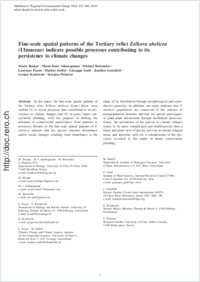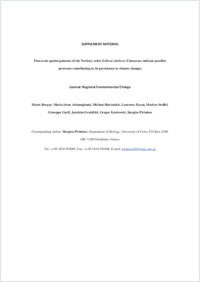Fine-scale spatial patterns of the Tertiary relict Zelkova abelicea (Ulmaceae) indicate possible processes contributing to its persistence to climate changes
- Bosque, Marta Department of Biology, University of Crete, Heraklion, Greece
- Adamogianni, Maria Irene Department of Biology, University of Crete, Heraklion, Greece
- Bariotakis, Michael Department of Biology, University of Crete, Heraklion, Greece
- Fazan, Laurence Department of Biology and Botanic Garden, University of Fribourg, Switzerland - Climatic Change and Climate Impacts, Institute for Environmental Sciences, University of Geneva, Carouge, Switzerland
- Stoffel, Markus Climatic Change and Climate Impacts, Institute for Environmental Sciences, University of Geneva, Carouge, Switzerland - Dendrolab.ch, Institute of Geological Sciences, University of Bern, Bern, Switzerland
- Garfi, Giuseppe Institute of Plant Genetics, National Research Council CNR , Palermo, Italy
- Gratzfeld, Joachim Botanic Gardens Conservation International BGCI, Kew , Richmond, Surrey, UK
- Kozlowski, Gregor Department of Biology and Botanic Garden, University of Fribourg, Switzerland - Natural History Museum, Fribourg, Switzerland
- Pirintsos, Stergios Department of Biology, University of Crete, Heraklion, Greece - Botanical Garden, University of Crete, Rethymnon, Greece
-
01.04.2014
Published in:
- Regional Environmental Change. - 2014, vol. 14, no. 2, p. 835–849
Tertiary relict trees
Fine scale spatial pattern
Plasticity
Disturbance
Facilitation
Zelkova abelicea
English
In this paper, the fine-scale spatial patterns of the Tertiary relict Zelkova abelicea (Lam.) Boiss. were studied (1) to reveal processes that contributed to its persistence to climate changes and (2) to assist future conservation planning, with the purpose of shifting the attention of conservation practitioners from patterns to processes. Results of the fine-scale spatial patterns of Z. abelicea indicate that the species tolerates disturbance and/or tracks changes resulting from disturbance in the range of its distribution through morphological and reproductive plasticity. In addition, our study indicates that Z. abelicea populations are conserved in the absence of metapopulation structure and that the species participates in plant–plant interactions through facilitation processes. Hence, the persistence of the species to climate changes seems to be more complicated and multifactorial than a linear and plain view of species survival in climate refugial areas, and therefore calls for a consideration of the processes revealed in this paper in future conservation planning.
- Faculty
- Faculté des sciences et de médecine
- Department
- Département de Biologie
- Language
-
- English
- Classification
- Biological sciences
- License
-
License undefined
- Identifiers
-
- RERO DOC 209904
- DOI 10.1007/s10113-013-0544-1
- Persistent URL
- https://folia.unifr.ch/unifr/documents/303593
Other files
Statistics
Document views: 140
File downloads:
- pdf: 239
- Supplementary material: 148

